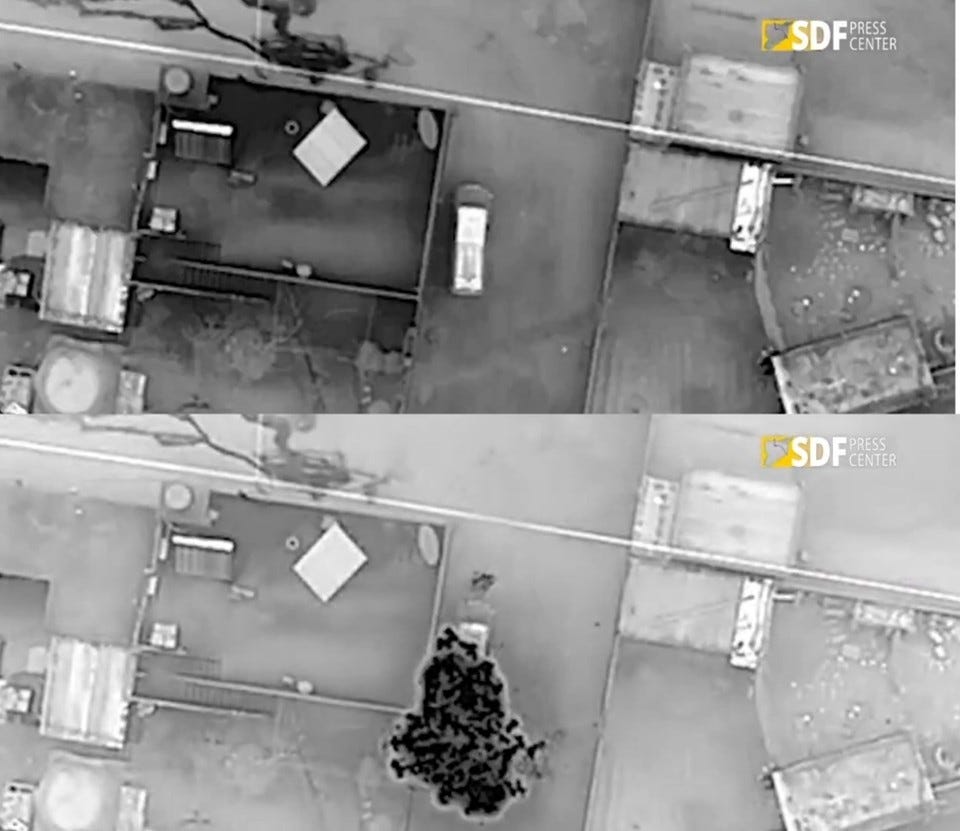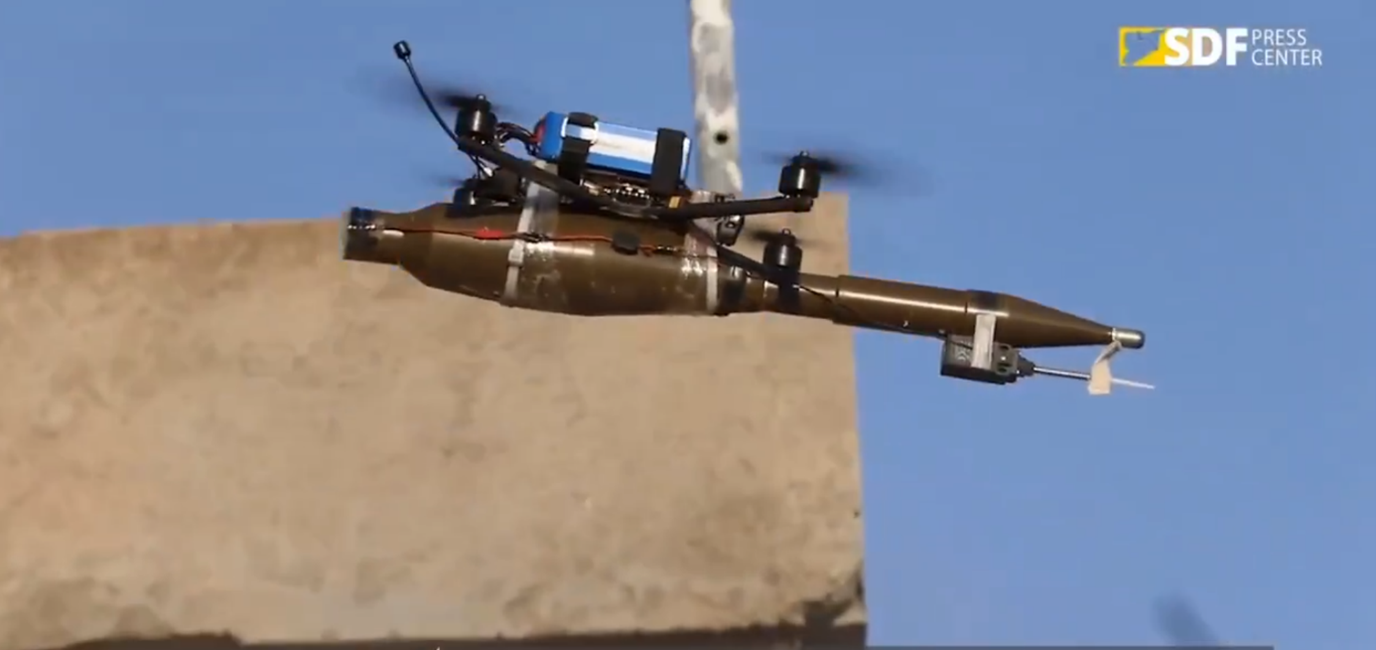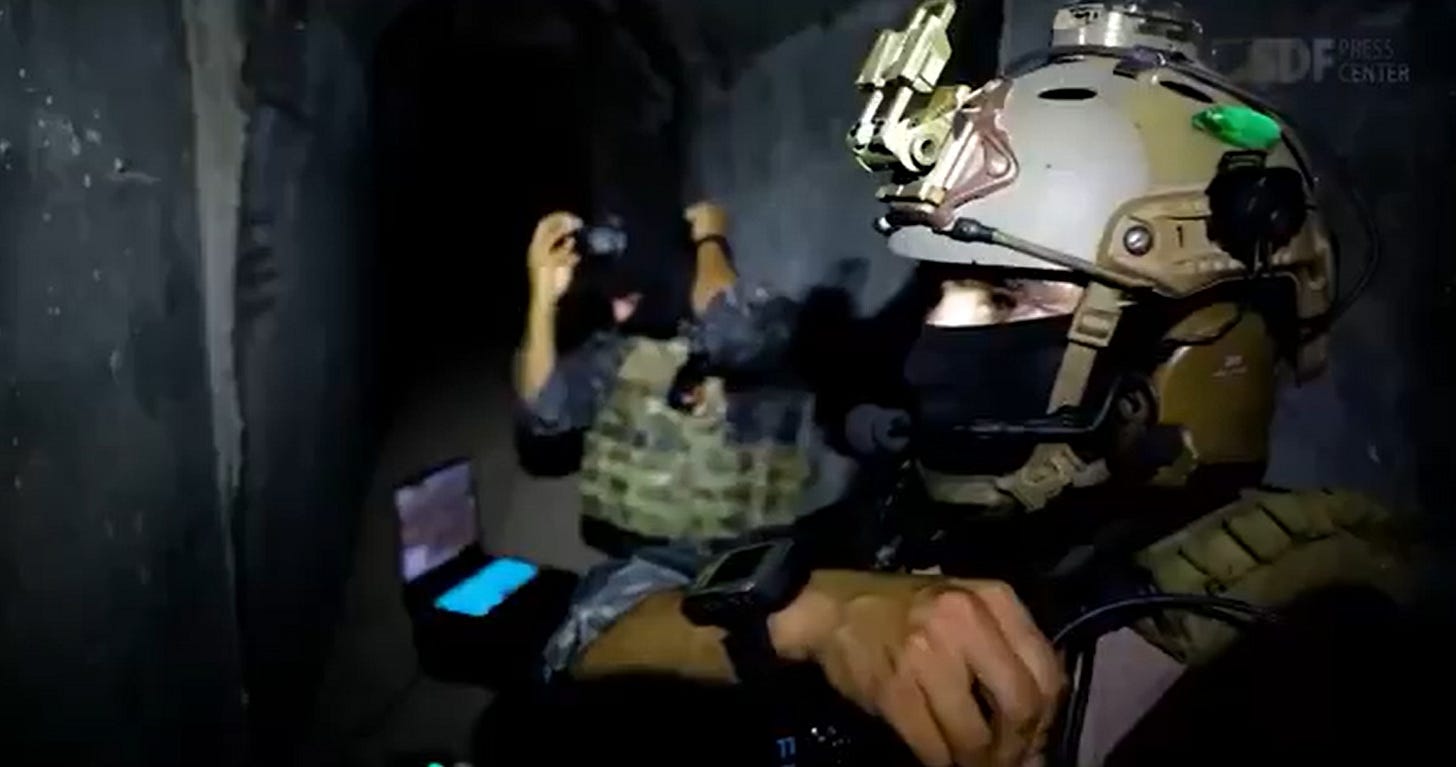In the pitch darkness of a January night, a Turkish-backed Syrian National Army (SNA) convoy moves cautiously along the road near Syria's strategic Tishreen Dam. Unknown to them, high above, a modified rotary-wing commercial drone equipped with thermal sensors silently tracks their movement until the column stops at its final staging area. Within minutes, the drone, which is also loaded with repurposed VOG-17 munitions, aligns its payload and strikes with remarkable accuracy. Parked vehicles, visible only as bright thermal signatures moments before, erupt in flames that illuminate the night sky.

This and other similar scenes played out repeatedly in recent weeks around the Tishreen Dam, exemplifying how the largely Kurdish-led Syrian Democratic Forces (SDF) have adapted the now-familiar patterns of small drone warfare to their specific strategic needs. Following a path launched by the Islamic State (IS), blazed by Ukrainian forces, and refined by groups like jihadi-led HTS (Hay’at Tahrir al-Shame) in Syria, the SDF has developed a methodical approach to drone operations that emphasizes persistent attacks on the cheap, through the widespread adoption of commercial unmanned aerial vehicles (UAVs).
The numbers show rapid integration of proven techniques that have made headlines over and over in the past few years.
Open-source imagery released by SDF-linked outlets and analyzed by this author indicates a steep increase in drone operations in recent weeks, with more than twice the number of observed attacks in January 2025 (135) compared to the previous month (61). But (incomplete) numbers are not the only interesting indicator. The SDF has also improved its targeting choices and tactical employment, which reveal the most about its evolving capabilities.
Proven Technologies, Refined Tactics
Like most non-state and proto-state armed actors, the SDF relies primarily on modified commercial platforms for its air operations. Their arsenal mirrors what's become standard in contemporary drone warfare: easily accessible DJI and Autel drones for intelligence, surveillance, and reconnaissance (ISR) operations, cheap weaponized first-person view (FPV) drones for kamikaze-style kinetic strikes, and modified commercial rotary-wing UAVs for munitions delivery.
FPV drones are typically assembled from 7-inch Chinese carbon frames and other cheap components. They usually function with an analog video signal, which is cheaper than its digital counterpart.

Given the rapidly increasing number of attacks, the SDF seems to have established a robust and resilient supply chain that allows its Martyr Haroun Units to conduct relatively high-tempo operations. Interestingly, the SDF is also benefitting from crowdfunding initiatives, a phenomenon that emerged in Ukraine and has quickly turned into an essential lifeline for both Ukrainian and Russian forces.
The typical weapons are similarly familiar: adapted PG-7 pattern HEAT grenades attached to the FPV frame and repurposed 60mm mortar rounds, 40mm M433 or 30mm VOG-17 high-explosive munitions with 3D-printed stabilizing fins for dropping strikes. This combination of commercial platforms and repurposed munitions has become standard practice in conflicts from Ukraine to Sudan to Myanmar.
Overall, collected data reveal a clear prevalence of FPV attacks (63,7%), followed by explosive drops (36,3%).

Vehicle Trashers
What distinguishes the SDF's approach, thus, is not their technology but their targeting strategy. Analysis of their operations reveals a carefully considered focus on mobility denial. The statistics are telling: 57% of the strikes observed by this author are aimed at vehicles, which are more vulnerable compared to hardened structures and buildings and easier to strike compared to personnel.
This emphasis on vehicle targeting by the SDF likely reflects a sober understanding of their strategic situation, in which the Turkish-backed Syrian National Army enjoys greater capabilities and can rely on heavier, more advanced pieces of military equipment, as well as robust intelligence and drone support from Ankara. Rather than attempting to hold territory through conventional means, the SDF uses drones to deny the SNA freedom of movement and disrupt their logistics, affecting their ability to both establish a secure footprint in contested territory and launch major offensive operations.

The remaining target distribution - 26% personnel, 17% buildings, and 1% fixed equipment – seems to corroborate this emphasis on mobility denial. As a result, the SDF can level the battlefield or at least try to fight on less unfavorable terms against the SNA.
Operational Implementation
The SDF's concept of drone employment follows what has become standard practice in today’s small drone warfare. Commercial ISR drones operating at 150-300 meters above ground provide target acquisition, while follow-on strike platforms such as weaponized FPV UAVs or explosive-dropping drones conduct the attacks. At the same time, ISR platforms typically remain on station during and after strikes, enabling immediate battle damage assessment and rapid re-attack if necessary.

This combination of tactics, pioneered by the Islamic State in 2014-15, used on an industrial scale in Ukraine and then mimicked by various factions in Syria, Myanmar, and elsewhere, has proven remarkably effective, and above all, affordable. The SDF has employed drones worth between a few hundred and a few thousand dollars to destroy or damage expensive military equipment, including armored vehicles, counter-battery radars, and – recently – a Turkish Firtina T-155 self-propelled artillery system.
Their ground control infrastructure similarly follows established patterns. Semi-fixed situation rooms with multiple screens and ground support equipment located several kilometers behind the frontline coordinate the operations and build a comprehensive situational picture, while rapid deployable drone teams with portable ground-control stations provide tactical flexibility.

In general, this distributed approach is also meant to provide resilience to enemy countermeasures while ensuring a minimum degree of command and control capabilities in most situations. A key factor is the group’s use of tunnels, that allow drone operators (and other units) to move and transport equipment undetected and perform missions from concealed and secure locations.

The Tishreen Dam Drone Battleground
The concentration of operations around the Tishreen Dam and Manbij countryside is also indicative of the SDF's strategic priorities. The dam's critical importance to regional infrastructure makes it a key strategic asset, while the nearby hills and elevated terrain offer a favorable view over the surroundings.
In recent weeks, multiple locations under SNA control and even Turkish military outposts have experienced recurrent attacks, sometimes several times per day.
Overall, the rapid scaling of SDF drone operations - doubling in just one month - suggests a remarkable learning curve and successful absorption of lessons from other conflicts. As in other contexts, constant operational experimentation has been instrumental to this process and confirms the critical importance of integrating any given technology into a tailored and tested concept of operations to achieve maximum effects.
In this respect, the creation of specialized drone units follows the examples of HTS and, more generally, Ukrainian and Russian forces. According to recent reports, these units have received training and technical advice from former US special forces individuals.
SDF’s information warfare approach also follows established patterns. Quick release of strike footage serves both propaganda purposes and helps shape adversary behavior, a tactic refined by various forces in several recent conflicts.
So far, it appears the SDF has avoided the temptation to reinvent drone warfare, instead focusing on implementing proven tactics with increasing efficiency.

Implications
Rather than technological innovation, the SDF's drone program, and use represents yet another example of effective implementation of what's becoming an increasingly widespread and common practice in modern warfare.
Their success lies less in absolute technical advances and more in meticulous target selection, mission planning, and tactical adaptation. Nevertheless, it is worth noting that the SDF has also been quicker than the SNA to rapidly adopt cheap drones, particularly FPV systems, at scale and to integrate them into its combat operations. In a recent interview, an SDF commander revealed that their use of small drones started in 2015 and that SDF has invested significant resources to build its drone capabilities and train its specialized personnel over the last decade. This indicates a longer more articulated and more committed process than the easily digestible and frenetic one shown by published footage.
Along with the structural lack of C-UAS capabilities on the part of the SNA, this has created a temporary tactical advantage that has allowed the SDF to disrupt adversarial operations and cause more than a headache to the SNA but also ushered in tactical imitation as the latter begins to deploy its own FPV drones.
As the conflict around the Tishreen Dam and adjacent territories continues, the SDF's approach offers insights into the maturation of drone warfare in low-intensity contexts. The peculiar focus on mobility denial, rather than territory control, may also be a preview of how other forces might adapt proven technologies and tactics to their specific strategic requirements. This process seems to follow a trend of growing technological sophistication among insurgents and non-state armed actors whose origins date back to the early 20th century.
The SDF case, along the HTS’s and that of others, also seems to reflect a broader trend: the standardization of small drone warfare tactics across different conflicts and forces. As commercial drone technology and basic weaponization techniques become widely understood and shared across social media and other information channels, the technical advantage may become increasingly short-lived and would depend not only on new technological leaps but also on tactical sophistication, perhaps more combined arms tactics employing other more conventional weapons systems and tactics and adaptation to the local context.









